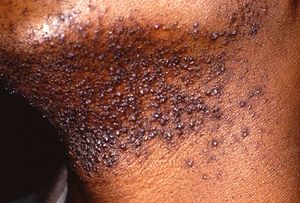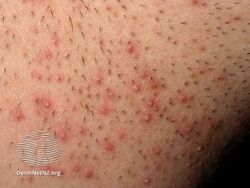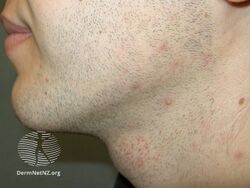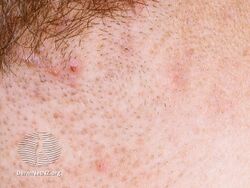Pseudofolliculitis barbae
| Pseudofolliculitis barbae | |
|---|---|
| Other names: Barber's itch, folliculitis barbae traumatica, razor bumps, scarring pseudofolliculitis of the beard, shave bumps | |
 | |
| Pseudofolliculitis barbae | |
| Pronunciation | |
| Specialty | Dermatology |
Pseudofolliculitis barbae (PFB) is a persistent irritation of skin caused by shaving.[1][2]
It was first described in 1956.[3]
Signs and symptoms
-
Pseudofolliculitis barbae
-
Pseudofolliculitis barbae
-
Pseudofolliculitis barbae
Related conditions
Razor burn is a less serious condition caused by shaving, characterized by mild to moderate redness and irritation on the surface of the skin. Unlike PFB, it is usually transient and there is no infection involved.
There is also a condition called folliculitis barbae. The difference between the two is the cause of the inflammation in the hair follicles. Where folliculitis barbae is caused by viral or bacterial infections, pseudofolliculitis is created by irritation from shaving and ingrown hairs.
Pseudofolliculitis nuchae, a related condition, occurs on the back of the neck, often along the posterior hairline, when curved hairs are cut short and allowed to grow back into the skin. Left untreated, this can develop into acne keloidalis nuchae, a condition in which hard, dark keloid-like bumps form on the neck. Both occur frequently in black men in the military. Here it is so common that services often have known protocols for management. [4]
Cause
Pseudofolliculitis barbae (PFB) is most common on the face, but it can also happen on other parts of the body where hair is shaved or plucked, especially areas where hair is curly and the skin is sensitive, such as genital shaving (more properly termed pseudofolliculitis pubis or PFP).[5]
After a hair has been shaved, it begins to grow back. Curly hair tends to curl into the skin instead of straight out the follicle, leading to an inflammation reaction. PFB can make the skin look itchy and red, and in some cases, it can even look like pimples. These inflamed papules or pustules can form especially if the area becomes infected.[6]
This is especially a problem for some men who have naturally coarse or tightly curling thick hair. Curly hair increases the likelihood of PFB by a factor of 50.[7] If left untreated over time, this can cause keloid scarring in the beard area.[8]
Pseudofolliculitis barbae can further be divided into two types of ingrown hairs: transfollicular and extrafollicular. The extrafollicular hair is a hair that has exited the follicle and reentered the skin. The transfollicular hair never exits the follicle, but because of its naturally curly nature curls back into the follicle causing fluid build-up and irritation.[9]
A common polymorphism in a keratin gene (K6hf) has been linked to PFB, suggesting that it may be a genetic risk factor.[10] This sequence change leads to an amino acid substitution in the highly conserved helix initiation motif of the K6hf rod domain.[7] Carriers of the A12T polymorphism are six times more likely to develop PFB compared with people homozygous for the wild-type K6hf sequence.[10] This suggests K6hf mutation structurally weakens the companion layer separating the inner and outer root sheath and increases the chances that a beard hair will in-grow.[10]
Prevention
The most efficient prevention is to grow a beard.[11] For men who are required to, or simply prefer to shave, studies show the optimal length to be about 0.5 mm to 1 mm to prevent the hair growing back into the skin.[11] Using a beard trimmer at the lowest setting (0.5mm or 1mm) instead of shaving is an efficient alternative. The resulting faint stubble can be shaped using a standard electric razor on non-problematic areas (cheeks, lower neck).[medical citation needed]
For most cases, completely avoiding shaving for three to four weeks allows all lesions to subside, and most extrafollicular hairs will resolve themselves within at least ten days.[11] Permanent removal of the hair follicle is the only definitive treatment for PFB.[11] Electrolysis is effective but limited by its slow pace, pain and expense. Laser-assisted hair removal is effective.[11] There is a risk of skin discoloration and a very small risk of scarring.[9]
Some men use electric razors to control PFB. Those who use a razor should use a single blade or special wire-wrapped blade to avoid shaving too closely, with a new blade each shave.[11] Shaving in the direction of hair growth every other day, rather than daily, may improve pseudofolliculitis barbae. If one must use a blade, softening the beard first with a hot, wet washcloth for five minutes or shave while showering in hot water can be helpful. Some use shaving powders (a kind of chemical depilatory) to avoid the irritation of using a blade. Barium sulfide-based depilatories are most efficient, but produce an unpleasant smell.[11]
Treatment
The simplest treatment for PFB is to let the beard grow.[11] Complete removal of the hair from its follicle is not recommended. Severe or transfollicular hairs may require removal by a dermatologist.[medical citation needed]
Medications are also prescribed to speed healing of the skin. Clinical trials have shown glycolic acid-based peels to be an effective and well-tolerated therapy which resulted in significantly fewer PFB lesions on the face and neck.[11] The mechanism of action of glycolic acid is unknown, but it is hypothesized that straighter hair growth is caused by the reduction of sulfhydrylbonds in the hair shaft by glycolic acid, which results in reduced re-entry of the hair shaft into the follicular wall or epidermis.[11] Salicylic acid peels are also effective.[12] Prescription antibiotic gels (Benzamycin, Cleocin-T) or oral antibiotics are also used. Benzoyl peroxide may be used topically, combined or not with prescription antibiotics.[13] Retin-A is a potent treatment that helps even out any scarring after a few months. It is added as a nightly application of Retin-A cream 0.05–0.1% to the beard skin while beard is growing out. Tea tree oil, witch hazel, and hydrocortisone are also noted as possible treatments and remedies for razor bumps.[medical citation needed]
Legal
In 1991, the Eighth Circuit Court of Appeals found that Domino's Pizza's policy of not allowing beards for employees created a disparate impact by excluding a quarter of black men from employment, but not an equivalent number of white men, thus violating Title VII of the Civil Rights Act of 1964.[14] In contrast, in 1993, the Eleventh Circuit Court of Appeals upheld the Atlanta fire department's "no-beard" policy because it was justified by a "business necessity", in that case the fact that even short beards interfered with firefighters' use of self-contained breathing apparatus.[15]
See also
References
- ↑ Rapini, Ronald P.; Bolognia, Jean L.; Jorizzo, Joseph L. (2007). Dermatology: 2-Volume Set. St. Louis: Mosby. ISBN 978-1-4160-2999-1.
- ↑ "pseudofolliculitis barbae" at Dorland's Medical Dictionary
- ↑ Alexander, A. M.; Delph, W. I. (1974). "Pseudofolliculitis barbae in the military. A medical, administrative and social problem". Journal of the National Medical Association. 66 (6): 459–464, 479. PMC 2609333. PMID 4436875.
- ↑ Pseudofolliculitis of the beard and Acne Keloidalis Nuchae (PDF). Technical Bulletin. Vol. TB MED 287. U.S. Army. Archived (PDF) from the original on 27 July 2018. Retrieved 15 October 2019.
- ↑ Garcia, Raymond L. (1975-01-01). "Pseudofolliculitis Pubis". Archives of Dermatology. 111 (1): 130–130. doi:10.1001/archderm.1975.01630130132022. ISSN 0003-987X. Archived from the original on 2021-08-29. Retrieved 2021-05-13.
- ↑ Ogunbiyi, Adebola (2019-04-16). "Pseudofolliculitis barbae; current treatment options". Clinical, Cosmetic and Investigational Dermatology. 12: 241–247. doi:10.2147/CCID.S149250. ISSN 1178-7015. PMC 6585396. PMID 31354326. Archived from the original on 2021-08-29. Retrieved 2021-05-13.
- ↑ 7.0 7.1 Winter, H.; Schissel, D.; Parry, D. A. D.; Smith, T. A.; Liovic, M.; Birgitte Lane, E.; Edler, L.; Langbein, L.; Jave-Suarez, L. F.; Rogers, M. A.; Wilde, J.; Peters, G.; Schweizer, J. (2004). "An Unusual Ala12Thr Polymorphism in the 1A alpha-Helical Segment of the Companion Layer-Specific Keratin K6hf: Evidence for a Risk Factor in the Etiology of the Common Hair Disorder Pseudofolliculitis Barbae". Journal of Investigative Dermatology. 122 (3): 652–657. doi:10.1111/j.0022-202X.2004.22309.x. PMID 15086549.
- ↑ Florida, Daryl A. Norwood, PharmD Associate Professor of Pharmacy Practice Dovena Michel, PharmD, BCPS Assistant Professor Nathaniel E. Eraikhuemen, PharmD Associate Professor of Pharmacy Practice College of Pharmacy and Pharmaceutical Sciences Florida A&M University-Davie Instructional Site Davie, Florida Antonio J. Carrion, PharmD, MPH, AAHIVP Assistant Professor of Pharmacy Practice College of Pharmacy and Pharmaceutical Sciences Florida A&M University–Tallahassee Instructional Site Tallahassee. "Pseudofolliculitis Barbae: Prevention and Treatment". www.uspharmacist.com. Archived from the original on 2020-10-20. Retrieved 2021-03-25.
- ↑ 9.0 9.1 Florida, Daryl A. Norwood, PharmD Associate Professor of Pharmacy Practice Dovena Michel, PharmD, BCPS Assistant Professor Nathaniel E. Eraikhuemen, PharmD Associate Professor of Pharmacy Practice College of Pharmacy and Pharmaceutical Sciences Florida A&M University-Davie Instructional Site Davie, Florida Antonio J. Carrion, PharmD, MPH, AAHIVP Assistant Professor of Pharmacy Practice College of Pharmacy and Pharmaceutical Sciences Florida A&M University–Tallahassee Instructional Site Tallahassee. "Pseudofolliculitis Barbae: Prevention and Treatment". www.uspharmacist.com. Archived from the original on 2020-10-20. Retrieved 2021-03-25.
- ↑ 10.0 10.1 10.2 McLean, W. H. I. (2004). "Close Shave for a Keratin Disorder-K6hf Polymorphism Linked to Pseudofolliculitis Barbae". Journal of Investigative Dermatology. 122 (3): xi–xiii. doi:10.1111/j.0022-202X.2004.22351.x. PMID 15086588.
- ↑ 11.0 11.1 11.2 11.3 11.4 11.5 11.6 11.7 11.8 11.9 Halder, RM; CI Roberts; PK Nootheti; AP Kelly (2006). "Dermatologic Disease in Blacks". Dermatology and dermatological therapy of pigmented skins. Boca Raton: Taylor & Francis. pp. 331–55. ISBN 9780849314025.
- ↑ Roberts, W. E. (2004). "Chemical peeling in ethnic/dark skin". Dermatologic Therapy. 17 (2): 196–205. doi:10.1111/j.1396-0296.2004.04020.x. PMID 15113287.
- ↑ Cook-Bolden FE, Barba A, Halder R, Taylor S (2004). "Twice-daily applications of benzoyl peroxide 5%/clindamycin 1% gel versus vehicle in the treatment of pseudofolliculitis barbae". Cutis. 73: 18–24. PMID 15228130.
{{cite journal}}: CS1 maint: multiple names: authors list (link) - ↑ Bradley v. Pizzaco of Nebraska, Inc., 926 F. 2d, 714 (8th Cir. 1991).
- ↑ Fitzpatrick v. City of Atlanta, 2 F.3d 1112 Archived 2015-05-14 at the Wayback Machine (11th Cir. 1993).
External links
| Classification | |
|---|---|
| External resources |


